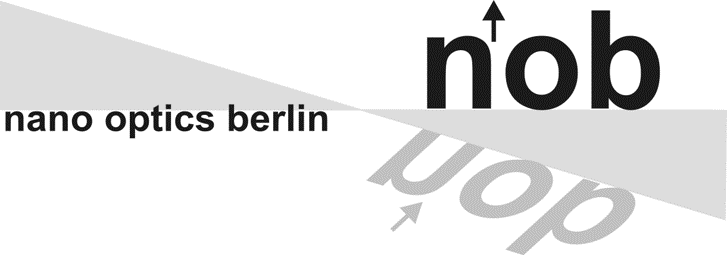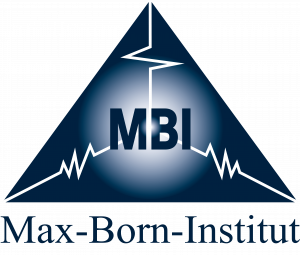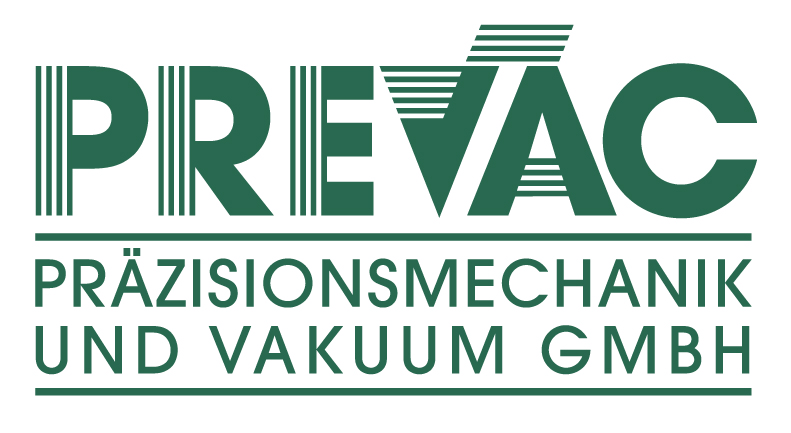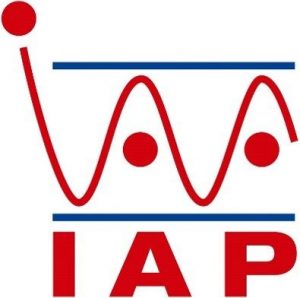MOSFER
Modular spectrometer with femtosecond resolution for soft X-rays
Project funding
Co-financing
Investitionsbank Berlin
IBB

Europäischer Fonds für regionale Entwicklung
EFRE

Project partners
NOB Nano Optics Berlin GmbH

Max-Born-Institut
für Nichtlineare Optik und
Kurzzeitspektroskopie im Forschungsverbund Berlin e. V.

PREVAC
Präzisionsmechanik
und Vakuum GmbH

Institut
für angewandte Photonik e.V.

Duration
Start : 01.01.2020
End: 31.12.2022
Project goal
Features
– Modular design, “table top”
– Energy range 50 eV – 1500 eV
– Energy resolution (E/ΔE) ≈ 1000 – 2000
– Efficiency > 10%
– Vacuum 10-5 – 10-8 mbar
– Reflective zone plates on curved substrates
Application
– Characterization of laboratory X-ray sources such as higher harmonic radiation (HHG) and Radiation from Laser Produced Plasmas (LPP)
– High-resolution ultra-short-time X-ray spectroscopy in the laboratory:
NEXAFS
XAS
XES
RIXS
Description
The investigation and characterization of materials with a spatial resolution in the range of a few picometers (pm) and a time resolution in the range of femtoseconds (fs) and below is becoming increasingly important for understanding the nature of physical processes. Due to the small wavelength, X-rays are indispensable as a “tool” for the production and investigation of nanostructures. This is taken into account, among other things, by providing the next generation of high-brilliance X-ray light sources, such as free electron lasers (FEL) [1] or linear accelerators with energy recovery (ERL) [2]. At the same time, laboratory X-ray sources such as high harmonics (HHG) [3] or laser-generated plasma sources (LPP) [4] are increasingly being developed as flexible, widely applicable supplements to these large-scale research facilities. This applies in particular to the extremely short pulse duration in the sub-fs range, which so far can only be realized with HHG sources [5].
The spectroscopy of molecular systems with soft X-rays has become increasingly important in recent years. Highly brilliant synchrotron radiation sources were used in X-ray absorption (X-Ray Absorption = XAS) and emission spectroscopy (X-Ray Emission = XES) as well as in X-ray scattering experiments (Resonant Inelastic X-Ray Scattering = RIXS) to study a variety of molecular interactions. Examples include the investigation of the structural dynamics of 3d metal-ligand complexes or hydrogen bonds in liquids, especially in water [6, 7] using oxygen K-edges XAS, XES and RIXS. Recently, time-resolved XAS, XES and RIXS experiments in connection with special short-pulse setups at synchrotrons and FELs have played an important role. Experimental “table-top” HHG setups have been available for a few years, which also provide soft X-ray radiation in the so-called water window (photon energy range 285 to 540 eV) in the laboratory, for example for XAS investigations on the carbon K-edge of organic molecules [8, 9]. There are first attempts to make the region of the nitrogen and oxygen K-edges available for these sources [10, 11].
The properties of many materials are largely determined by their structure on the nanometer scale. Exact knowledge of the structure and its connection with the material properties are therefore of fundamental importance in order to understand the functionality of the materials and to influence them in a targeted manner. The investigation of these materials with the help of ultra-short pulses in the soft X-ray range offers e.g. the possibility to track the magnetization dynamics with fs time resolution and even to map them on the nanometer scale [12]. To do this, the wavelength of the radiation must be adjusted to specific absorption edges of the materials used, which allows targeted access to the magnetization of the individual elementary components. For optically induced magnetic switching processes, some rare earths (Gd, Tb, Dy) are of particular interest, which show a strong magnetic contrast at their N5 edges around 150 eV. Holographic methods in particular can be used for spatial imaging, which benefit directly from the good coherence properties of HHG radiation or FEL radiation and – in contrast to lens-based methods – allow simple implementation of the optical excitation [13-15].
The advantage of laser-rubbed short-pulse X-ray sources for spatially and time-resolved structural investigations results from the fact that the pulsed driver laser can be used both to excite the system to be examined and to “generate” the X-rays. In this way, “pump-probe” experiments can be carried out relatively easily and the so-called “jitter” problem of synchronizing X-ray and optical pulses on the fs time scale can be avoided. On the other hand, laboratory sources emit an X-ray photon flux several orders of magnitude lower than synchrotron or FEL sources. Therefore, for practical applications of short-pulse laboratory X-ray sources, it is necessary to develop a new type of equipment with a significantly higher efficiency of the optical elements compared to previously known solutions.
- Seddon, E.A., et al., Short-wavelength free-electron laser sources and science: a review. Reports on Progress in Physics, 2017. 80(11): p. 115901.
- Akemoto, M., et al., Construction and commissioning of the compact energy-recovery linac at KEK. Nuclear Instruments & Methods in Physics Research Section a-Accelerators Spectrometers Detectors and Associated Equipment, 2018. 877: p. 197-219.
- Teichmann, S.M., et al., 5-keV Soft X-ray attosecond continua. Nature Communications, 2016. 7.
- Mantouvalou, I., et al., High average power, highly brilliant laser-produced plasma source for soft X-ray spectroscopy. Review of Scientific Instruments, 2015. 86(3): p. 035116.
- Li, J., et al., 53-attosecond X-ray pulses reach the carbon K-edge. Nature Communications, 2017. 8.
- Wernet, P., et al., The structure of the first coordination shell in liquid water. Science, 2004. 304(5673): p. 995-999.
- Nilsson, A., et al., X-ray absorption spectroscopy and X-ray Raman scattering of water and ice; an experimental view. Journal of Electron Spectroscopy and Related Phenomena, 2010. 177(2-3): p. 99-129.
- Pertot, Y., et al., Time-resolved x-ray absorption spectroscopy with a water window high-harmonic source. Science, 2017.
- Attar, A.R., et al., Femtosecond x-ray spectroscopy of an electrocyclic ring-opening reaction. Science, 2017. 356(6333): p. 54-59.
- Kleine, C., et al., Soft X-ray Absorption Spectroscopy of Aqueous Solutions Using a Table-Top Femtosecond Soft X-ray Source. The Journal of Physical Chemistry Letters, 2019. 10(1): p. 52-58.
- Gregory, J.S., et al., Water-window soft x-ray high-harmonic generation up to the nitrogen K-edge driven by a kHz, 2.1 μm OPCPA source. Journal of Physics B: Atomic, Molecular and Optical Physics, 2016. 49(15): p. 155601.
- Hennecke, M., et al., Angular Momentum Flow During Ultrafast Demagnetization of a Ferrimagnet. Physical Review Letters, 2019. 122(15).
- Caretta, L., et al., Fast current-driven domain walls and small skyrmions in a compensated ferrimagnet. Nature Nanotechnology, 2018. 13(12): p. 1154-+.
- Wang, T.H., et al., Femtosecond Single-Shot Imaging of Nanoscale Ferromagnetic Order in Co/Pd Multilayers Using Resonant X-Ray Holography. Physical Review Letters, 2012. 108(26): p. 6.
- Schaffert, S., et al., High-resolution magnetic-domain imaging by Fourier transform holography at 21 nm wavelength. New Journal of Physics, 2013. 15: p. 10.
